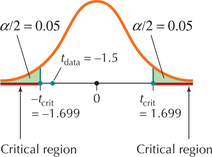EXAMPLE 19 t Test for μ using critical-value method: two-tailed test
CNN reported in 2014 that, even after factoring in part-time jobs, Americans worked an average of 38 hours per week. Suppose a social science researcher disputes this finding and is interested in testing whether the population mean number of hours worked per week differs from 38. A random sample of n=30 working Americans yields a sample mean of ˉx=35.26 hours worked, with a sample standard deviation of s=10 hours. If the conditions are met, perform the appropriate hypothesis test using level of significance α=0.10.
Solution
Because n=30≥30, we may proceed with the t test.
Step 1 State the hypotheses.
The key words “differs from” indicate a two-tailed test, with μ0=38, because we are testing whether μ differs from 38. So our hypotheses are
H0:μ=38versusHa:μ≠38
where μ represents the population mean number of hours worked per week.
 FIGURE 21 Critical region for two-tailed test.
FIGURE 21 Critical region for two-tailed test.Step 2 Find tcrit and state the rejection rule.
To find tcrit for a two-tailed test with level of significance α=0.10, we look in the 0.10 column in the “Area in two tails” section of Table D in the Appendix. The degrees of freedom df=n-1=29 gives us tcrit=1.699. From Table 8, the rejection rule is: “Reject H0 if tdata≥1.699 or tdata≤-1.699.”
Page 529Step 3 Calculate tdata:
tdata=ˉx-μ0s/√n=35.26-3810/√30≈-1.5
Step 4 State the conclusion and the interpretation.
tdata=-1.5 is not ≥1.699 and it is not ≤−1.699; therefore, we do not reject H0. See Figure 21. There is insufficient evidence, at level of significance α=0.10, that the population mean number of hours worked per week differs from 38.
NOW YOU CAN DO
Exercises 9–14.